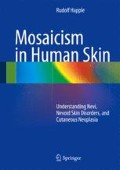Abstract
Most of the benign and all of the malignant cutaneous neoplasias can be taken as mosaic lesions. They usually reflect either loss of heterozygosity or postzygotic new mutations present in a heterozygous state. By tradition, benign melanocytic proliferations are called nevi. All other benign cutaneous neoplasias do not represent nevi. For these tumors and for some malignant neoplasias such as basal cell carcinoma, the two-hit model may not always be true. Rather, a four-mutation model of tumorigenesis may be envisaged. For other malignant skin tumors such as squamous cell carcinoma or malignant melanoma, a multistep model of carcinogenesis can be taken as certain.
Access this chapter
Tax calculation will be finalised at checkout
Purchases are for personal use only
References
Armitage P, Doll R (1957) A two-stage theory of carcinogenesis in relation to the age distribution of human cancer. Br J Cancer 11:161–169
Christiaans I, Kenter SB, Brink HC, van Os TA, Baas F, van den Munckhof P, Kidd AM, Hulsebos TJ (2011) Germline SMARCB1 mutation and somatic NF2 mutations in familial multiple meningiomas. J Med Genet 48:93–97
Den Otter W, Koten JW, Derkinderen DJ (1987) Carcinogenesis revisited. Cancer Invest 5:69–74
Den Otter W, Koten JW, Van der Vegt BJ, Beemer FA, Boxma OJ, De Graaf PW, Derkinderen DJ, Hill FW, Huber J, Klein WR et al (1990) Hereditary cancer and its clinical implications: a view. Anticancer Res 10:489–495
Den Otter W, Koten JW (1999) A 4-mutation model of carcinogenesis for tumour suppressor genes. Anticancer Res 19:4845–4852
Derkinderen DJ, Boxma OJ, Koten JW, Den Otter W (1990) Stochastic theory of oncogenesis. Anticancer Res 10:497–504
El-Naggar AK (2007) Pathobiology of head and neck squamous tumorigenesis. Curr Cancer Drug Targets 7:606–612
Hadfield KD, Newman WG, Bowers NL, Wallace A, Bolger C, Colley A, McCann E, Trump D, Prescott T, Evans DG (2008) Molecular characterisation of SMARCB1 and NF2 in familial and sporadic schwannomatosis. J Med Genet 45:332–339
Hunt JL, Barnes L, Lewis JS Jr, Mahfouz ME, Slootweg PJ, Thompson LD, Cardesa A, Devaney KO, Gnepp DR, Westra WH, Rodrigo JP, Woolgar JA, Rinaldo A, Triantafyllou A, Takes RP, Ferlito A (2013) Molecular diagnostic alterations in squamous cell carcinoma of the head and neck and potential diagnostic applications. Eur Arch Otorhinolaryngol
Knudson AG Jr (1971) Mutation and cancer: statistical study of retinoblastoma. Proc Natl Acad Sci U S A 68:820–823
Knudson AG Jr, Hethcote HW, Brown BW (1975) Mutation and childhood cancer: a probabilistic model for the incidence of retinoblastoma. Proc Natl Acad Sci U S A 72:5116–5120
Koten JW, Neijt JP, Zonnenberg BA, Den Otter W (1993) The difference between benign and malignant tumours explained with the 4-mutation paradigm for carcinogenesis. Anticancer Res 13:1179–1182
Nambiar S, Mirmohammadsadegh A, Bar A, Bardenheuer W, Roeder G, Hengge UR (2004) Applications of array technology: melanoma research and diagnosis. Expert Rev Mol Diagn 4:549–557
Peeper DS (2011) Oncogene-induced senescence and melanoma: where do we stand? Pigment Cell Melanoma Res 24:1107–1111
Pfeifer GP, Besaratinia A (2012) UV wavelength-dependent DNA damage and human non-melanoma and melanoma skin cancer. Photochem Photobiol Sci 11:90–97
Reis AH, Vargas FR, Lemos B (2012) More epigenetic hits than meets the eye: microRNAs and genes associated with the tumorigenesis of retinoblastoma. Front Genet 3:284
Sestini R, Bacci C, Provenzano A, Genuardi M, Papi L (2008) Evidence of a four-hit mechanism involving SMARCB1 and NF2 in schwannomatosis-associated schwannomas. Hum Mutat 29:227–231
Author information
Authors and Affiliations
Rights and permissions
Copyright information
© 2014 Springer-Verlag Berlin Heidelberg
About this chapter
Cite this chapter
Happle, R. (2014). A Note on Neoplastic Skin Lesions. In: Mosaicism in Human Skin. Springer, Berlin, Heidelberg. https://doi.org/10.1007/978-3-642-38765-4_13
Download citation
DOI: https://doi.org/10.1007/978-3-642-38765-4_13
Published:
Publisher Name: Springer, Berlin, Heidelberg
Print ISBN: 978-3-642-38764-7
Online ISBN: 978-3-642-38765-4
eBook Packages: MedicineMedicine (R0)

